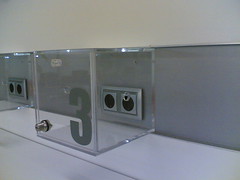Posted: March 7th, 2007 | No Comments »
In my recent talk at LIFT, I used a photo of electrical outlets in public spaces denying their public use to highlight the issues around the ownership of the infrastructure providing ubiquitous experiences. I wanted to suggest that it does not mean that the infrastructure is out for us to profit from it. In other words, access has often a cost (financial, proper devices, privacy, time, …). In the meantime I spotted this beautiful transparent box at the Espacio Movistar that prevent people to get access to plug their electric devices unless that have a key. It reminds me of some fast food restaurants in Switzerland in which customers need to ask for the key or codepass at the counter to get access to the restrooms.

To further exemplify my thoughts, it seems that the increase of mobile devices in need for power has become a problem and a business opportunity in some airports.

Does the Dallas/Forth-Worth airpot set the standard by now providing pay-per-use electricity?
Relation to my thesis: the constraints to seamlessness
Posted: March 7th, 2007 | No Comments »
I have been enjoying Mika Raento‘s works since his Symbian Hacks for Context-Aware Programming that helped me a great deal on some projects. Since then, Mika has been working (among other things) on Jaiku. As one of the top mobile ubiquitous application developer out there, Mika keeps track of his frustration on the technologies and platforms that do not deliver the expected quality. For example he has been highlighting the issues on building IP-based application on top of 3G/UMTS
3G/UMTS is nowhere near working! Moving around in central Helsinki, an E61 drops the network fully or switches between 2G and 3G (dropping TCP connections) every few minutes. Establishing calls may take 5 tries.
Moving outside central urban areas, an N80 will constantly try to connect to a 3G cell, fail, connect to a 2G cell, notice there’s a 3G cell available, try to connect, fail, repeat. The phone heats up and kills the battery in about an hour.
Sending a few packets of data every few minutes kills most phones’ battery in about 8–12 hours on 3G. The same amount of traffic per time unit on 2G (GPRS) allows 2–3 days of use.
So neither the network nor the GSM chipsets is up to the task yet. I think the people pining for 3G at the moment are not actually using it for anything real.
In a recent talk, he mentioned his problems of using TCP as part of a solution to provide Jabber fro Jaiku:
The trick, is that the “reliability’’ this documents talk about is quite different with what we tend to think of as reliable. TCP’s reliability means in-order delivery and integrity (no bits flipped). What people often think when they think of reliable is some vague idea of “data getting to the other end’’. Which of course isn’t the case.
Relation to my thesis: Mika provides a timely down to the ground really check on the development of mobile, context-aware applications. Yes ubicomp is here, but it often gets down to the science of “bricolage”?
Posted: March 5th, 2007 | No Comments »
My paper for the Pervasive 2007 Doctoral Colloquium has been accepted. It is an extended version of the CHI’07 submission.
Bridging the Social-Technical Gap in Location-Aware Computing
Abstract. Building ubiquitous applications that exploit location requires integrating underlying infrastructure for linking sensors with high-level representation of the measured space to support human activities. However, the real world constraints limit the efficiency of location technologies. The inherent spatial uncertainty embedded in mobile and location systems constantly challenges the coexistence of digital and physical spaces. Consequently, the technical mechanisms fail to match the highly flexible, nuanced, and contextual human spatial activities. These discrepancies generate a social-technical gap between what should be socially supported and what can be technically achieved. My research aims at exploring, and hopefully reducing this gap in the context of location-aware computing.
Relation to my thesis: I am pretty glad that people like Shwetak Patel (Supporting Location and Proximity-Based Studies in Natural Settings) and Leif Oppermann (Extending Authoring Tools for Location-Aware Applications with an Infrastructure Visualisation Layer) will also present their work. Hopefully Leif will also talk about his location based mobile phone game Love City. Pervasive 2007 will take place on May 13-16 in Toronto, Ontario, Canada.



